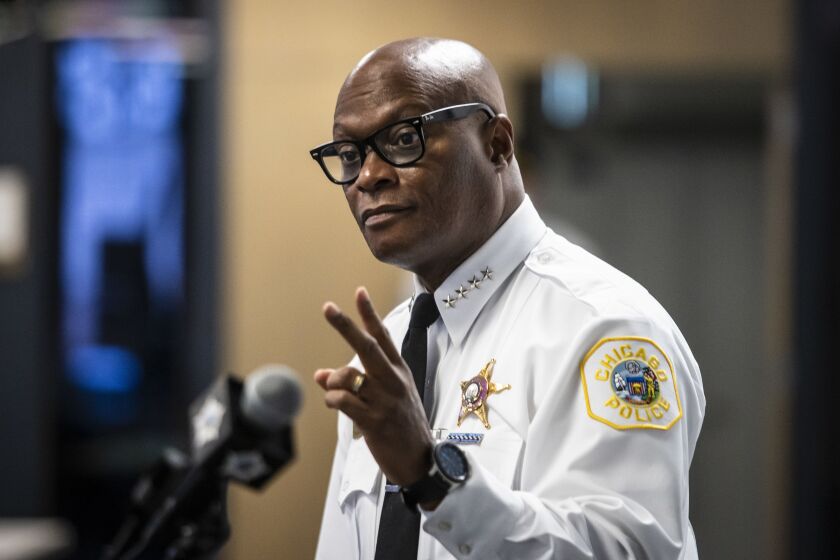For Chicago Police Supt. David Brown, the situation on the ground changed as soon as he arrived in town.
On April 2, the day Mayor Lori Lightfoot announced she’d selected Brown to be the next leader of the department, the CPD reported the first coronavirus-related death of an officer — that of veteran undercover cop Marco DiFranco. Two more officers have since died of of the virus, while more than 700 have tested positive.
A global pandemic, surging gun violence and widespread civil unrest quickly revealed that the ongoing structural reorganization of the department — put into motion by Brown’s predecessor, interim Supt. Charlie Beck — would need changing.
“So the interim superintendent does a major reorganization of the department, and that’s still not fully implemented as I start,” Brown said in a radio interview earlier this week. “I fully implemented [it] in the first parts of May, and almost immediately I understand, along with people in the community, that that’s an outdated reorganization because of what’s changed on the ground: the civil unrest, the pushback against police, COVID-19 and unprecedented violence. So I have to start planning another reorganization in order to deal with what is at hand.”
Gone are the days of temporarily moving officers to high-crime areas from quieter ones. Brown got an early lesson in Chicago politics when Northwest Side aldermen complained they weren’t told before Brown dispatched cops from their wards to the West Side.
To stem the tide of shootings and stop the frequent reassignment of officers, the CPD created two new teams: the Community Safety Team and Critical Incident Response Team.
“These teams reflect Superintendent Brown’s priorities of moving more officers into the communities they serve, and are rooted in balancing crime-fighting with community connection,” the department said in a statement. “Taking a break from past practices, these teams are focused on building trust with residents to address their needs head-on, while strategically stemming violence in the most vulnerable neighborhoods.
The Community Safety Team will operate mostly on the South and West sides, supplementing efforts by district commanders while also reaching out to community leaders to forge stronger neighborhood ties.
The Critical Incident Response Team will focus primarily on large gatherings downtown, which have become common in recent weeks and months.
Chicago saw widespread protests and looting in late May after the death of George Floyd in Minneapolis on Memorial Day. Brown said when large gatherings manifested downtown, it forced the CPD to pull officers out of the South and West sides, where gun violence is most prevalent.
“Let us redirect our anger to the loss of life on the South and West sides of Chicago,” Brown said last month after a violent confrontation between police and protesters at the since-removed Christopher Columbus statue in Grant Park.
Shortly after taking the reins of the department, Brown told CPD leadership he wanted the city’s murder total to remain under 300 for 2020 — a tally not seen in Chicago since 1957.
Yet on May 31, during the height of the unrest, Chicago recorded 18 murders — making it the single most violent day in the city’s modern history. With nearly five months to go this year, the city has seen more than 440 murders. Chicago recorded 496 killings in all of 2019, according to the CPD.
Beyond the jarring number of shootings, many recent victims of gun violence were minors. Fifteen children have been shot to death in Chicago since June 20, according to Sun-Times records. Five were 10 years old or younger.
Meanwhile, four Chicago Police officers have been shot in just the last two weeks — with three wounded in a gun battle outside the department’s 25th District station on the Northwest Side last week.
Since his arrival, Brown has grown increasingly vocal in criticizing the Cook County criminal justice apparatus. He has called for revisions to the county’s home monitoring system and decried how frequently people charged with gun-related crimes are released from the Cook County Jail before trial.
“There’s no consequences to illegal gun possession in our criminal justice system,” he told reporters in July. “My hopes are that the deaths of these young people won’t be in vain and will prick the hearts of the decision-makers who release violent offenders on electronic monitoring back into these very communities to mete out this kind of violence every weekend.”
Cook County State’s Attorney Kim Foxx pushed back on Brown’s critiques this past week.
“We have asked for any data that they have that’s different from the data that we have,” Foxx said, because her office’s review doesn’t support the “narrative” that “these people are arrested with gun charges, and they’re right back out, and they’re committing new crimes.”
In late June, Brown met with the heads of the Chicago offices of the DEA, ATF, FBI and U.S. attorney. Sources with knowledge of what happened said Brown asked for more help in bringing gun and drug cases to the federal level, where penalties are more stringent than in state court.
Meanwhile, President Donald Trump ordered hundreds of additional federal agents to Chicago to help with gun and drug investigations as part of “Operation Legend.” About 20 people have been charged in federal gun cases in Chicago in the past two weeks — more than any other type of criminal charge filed.
The U.S. attorney’s office has also brought gun and drug charges against dozens of alleged gang members from the South and West sides.
The CPD’s structural changes and Chicago’s rise in violence come as the department struggles to comply with its federal consent decree, the court-enforced reform plan spurred by the killing of Laquan McDonald by former CPD officer Jason Van Dyke in 2014.
Maggie Hickey, the decree’s independent monitor, has said she and her team have opened an inquiry into CPD officers’ conduct during the days of unrest in late May.








